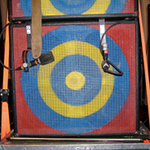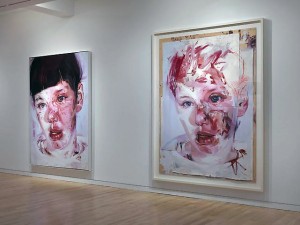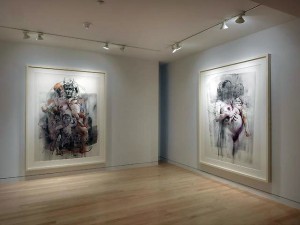Jenny Saville
Continuum
Gagosian Gallery
980 Madison Avenue, New York, NY
September 15–October 22, 2011
If any contemporary painter could stand toe to toe with Willem de Kooning, the late Abstract Expressionist currently enjoying a retrospective at the Museum of Modern Art, it’s Jenny Saville, a Brit returning to New York with her first exhibition here in eight years. Titled Continuum, it presents thirteen works on canvas and paper that showcase her mastery of the figure through splatters and stains, and through delicate, refined sketches and furious brushstrokes. Critics and historians have roundly criticized de Kooning for his rough treatment of women in his art. Saville has been no more sympathetic, depicting female corpses, burn victims, and the morbidly obese in the past, but the primary subject in those large-scale works is often herself, adding a crucial dimension to portrayals of women.
With Warholian repetition, Saville reworks four times the head of a preteen girl that appeared in an older painting, Stare (2004–5). For each iteration she renders the dark-brown bangs and prominent ear differently, a birthmark on one cheek disappearing entirely into the face of creamy pinks and lavenders, soaring crimsons, and dark abrasive reds the color of dried blood. Hung side by side, Red Stare Head I and Red Stare Head II (both 2007–11) are mirror images of each other. Paired across the room are Red Stare Head IV (2006–11) and Red Stare Collage (2007–9), a work comprising three large painted sheets of paper mounted on plywood. The messy, unfinished quality of the collage makes it the best of the group.
Saville’s obsession with a singular image persists in other works whose shock comes not only from the discordant mix of media—energetic lines of charcoal repeatedly interrupt the casually painted sections—but also from the unlikeliest of subjects: the classic Madonna and Child. Saville modernizes the nativity by presenting herself as the Virgin Mary; her infant daughter and toddler son compete for the Christ position. For the most resolved work, The Mothers (2011), she drew several variations of the scene on canvas, trying out numerous poses before setting the final composition in paint. Leaving the older, extraneous scribbles in place, Saville offers a strange simultaneity of movement and possibility.
By focusing on details such as belly buttons, penises, and swollen bellies, which suggest legacy, survival, and connections between generations, Saville cleverly acknowledges a competition not with contemporary artists but with Raphael, Leonardo, and Velázquez, just as de Kooning did before her. The title of her drawing that isolates the king’s daughter from Las Meninas (1656), called Study for Pentimenti V (Velázquez, Picasso, de Kooning) (2011), does this explicitly. Themes of tender domesticity and uses of traditional subject matter typically concede to innovation. Some could argue that Saville is playing it safe, but she seems to be exploring artistic advancement apart from edgy subject matter, with all the stubbornness and hesitance that comes with the process.






